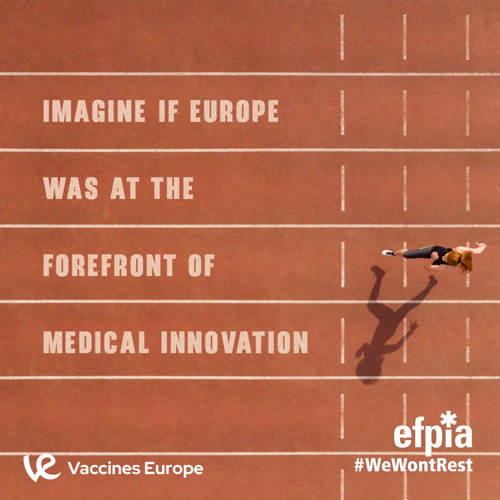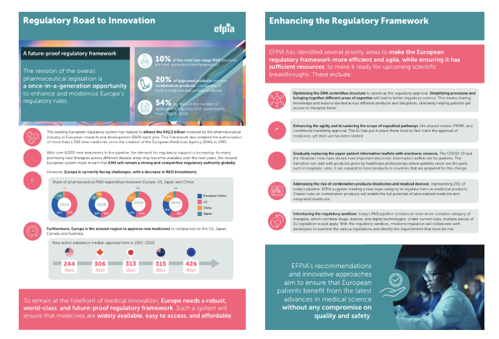Healthcare innovation moves fast – so should the European regulatory system (Guest blog)
What will the innovations of tomorrow look like and how can they be regulated effectively without delaying access?
This is a key question facing policymakers as they aim for EU competitiveness while ensuring patients get new technologies that address their needs. One of the most exciting ‒ and challenging ‒ features of today’s research landscape is the potential to tap into the combined power of advances in diagnostics, therapeutics and new data and digital tools, including artificial intelligence (AI), to create integrated healthcare solutions.
These solutions can address gaps in the patient journey and deliver better outcomes for patients with greater efficiency for health systems. The challenge facing lawmakers, as they consider reshaping EU pharma legislation, is in how to enable Europe to capitalise on this potential in a way that is sufficiently flexible to address rapid future advances in technology and innovation.
Unblocking regulatory bottlenecks
The current rules governing healthcare products were designed for a very different time, when few products combined a variety of technologies. Nowadays, however, the number of such products is rising, combining an increasing array of technologies that are regulated by different and disparate pieces of EU legislation.
Take, for example, an implantable device using AI technology to control the drug dose given to a patient. This may be covered by a range of legislative rules, including the general pharmaceutical legislation, the Medical Devices Regulation, the In Vitro Diagnostics Regulation, the AI Act and the European Health Data Space. All of which were developed for good reason, but also create a significant burden on the producer trying to comply with multiple rules for each product.

Policymakers can help to address these issues by ensuring that the various pieces of regulatory infrastructure are coherent, consistent and in sync, while clearly defining the decision-making pathway. This becomes even more critical as the EU is currently reviewing or advancing several of the above-mentioned frameworks in parallel to the pharma legislation. Now is the time to ensure we have a system that meets Europe’s future needs.
How the EMA can help
Joined up thinking and early dialogue are needed to support industry in generating the evidence required by various decision-makers, including national medicines regulators, the European Medicines Agency (EMA), Notified Bodies and national Health Technology Assessment (HTA) authorities. This is essential for patients and innovators, but also for the EU’s wider goal of maintaining a competitive life sciences sector.
EFPIA advocates for giving EMA a central role in overseeing the pathways for integrated healthcare solutions. This requires efficient and expertise-focused committees. We see a simplification of the Agency’s committee and stakeholder management structure as vital to streamline this complex system. This would, for example, provide the support to accelerate the development of solutions addressing unmet medical needs (UMN) as well as criteria for applying expedited pathways, including PRIME: priority medicines.
Creative solutions: a regulatory sandbox
Another key solution to the challenge of devising an agile legislative landscape will be the regulatory sandbox. This approach allows for regulatory controls while enabling disruptive innovation.
For some integrated products, bespoke development approaches will be needed to foster innovation without compromising on quality, safety or efficacy. The regulatory sandbox would give regulators and developers the opportunity to engage on how legislation could be applied to disruptive innovation. This approach may also be of value in cases where the application of multiple regulations reaches a level of unforeseen and unmanageable complexity.
The need for flexibility while ensuring safety, efficiency and quality is highest in areas of the greatest innovation. Take Advanced Therapy Medicinal Products (ATMPs), for example. ATMPs open the door to personalised and precise therapies that can prevent, diagnose, treat or cure disease at their source. They represent a significant advance on traditional one-size-fits-all approaches to treatment, but also challenge traditional approaches to regulation.
Collaboration is key to unlocking rapid innovation
The complexity inherent in modern healthcare innovation makes collaborative approaches a must. This means greater collaboration between stakeholders from across Europe in areas such as defining UMN, as well as global cooperation between regulators in Europe, the US, the UK, China and elsewhere.
The proposed revamp of Europe’s regulations on medicines includes several welcome features, such as greater use of electronic product information (ePI), real-world data/real-world evidence, and a digitally enabled regulatory system. While we welcome the proposals, it is crucial to avoid too many diverging approaches by Member States leading to an excessive level of regulatory granularity and stifling innovation for patients.
What we need to achieve together is a reimagined regulatory ecosystem that allows Europe to be a leader in the life sciences. Although it is not possible to write rules today that will remain fit-for-purpose for a generation, we must strive to build in the flexibility needed to cope with future waves of innovation.
From experience we know there is a risk that different lawmakers introduce changes into law at different points in time. This can eventually lead to the over-regulation of scientific and technological aspects – locking in patients, industry and regulators for years – or to regulations which become immediately redundant in light of rapid advances in innovation.
Only by being agile and adaptable can Europe be a leader in the life sciences. And only by engaging early and often with developers can regulators expect to ensure access to the life-enhancing integrated health solutions that patients need. Let’s work together to get this right. Now and in the future.
- - -
Discover more about EFPIA's recommendations for future-proofing the EU regulatory framework.


